Comparing On Cloud vs ASICS running shoes is another great running shoe match up. Both have some of the same traditional shoe features and yet, Cloud running is breaking the old school mold.
Over the years, I have been able to test out models from both brands to give you some personal insight along with basic shoe details.
We’ve got details on construction, fit, feel, fabric and more. But ultimately it’s really the feel on your foot that’s going to make the decision.
You’ll see I have tested a lot of these shoes and like both brands, but have some bias based on what feels good to me! So I definitely went in search of other opinions to round it out.
ASICS Vs On Cloud Key Differences
On Cloud and Asics offer a lot of similar features and models for all kinds of runners. There are options for moderate to max cushion and overpronation.
I would say neither brand is super high on the list of shoes that ultramarathon runners love, unlike the Hoka.
Asics has been around forever and is a long standing favorite of running stores and distance runners alike.
Meanwhile, On took hold in the triathlon market first and then quickly moved mainstream running.
I break down the differences in more detail below, but here’s a quick overview:
ASICS Running Shoes
- More narrow fit, especially in the heel and midsole
- Most ASICS are 8mm to 10mm, but they have a few that are 5mm
- Famous for its GEL technology, which provides shock absorption
- Designs a variety of shoes for many different sports
On Running Shoes
- Newer styles are a more average fit, some slightly wide
- Recognizable sole with the pods
- Claims their CloudTec sole reduces muscle fatigue and lowers HR
- Focus on improving speed off ground and reducing impact
- Mostly running shoes, but now has incredible jackets, pants, etc as well
If you’re looking for just a detailed look a On, checkout this full On Cloud Review >>
I’ve worn both brands and will add some personal thoughts, along with links to detailed reviews. Here you’ve got two of my well worn models!
ON Running vs ASICS Feature Comparison
While ON is newer to the running market, Asics has a long history that often makes it hard for many runners to switch to the newer style.
Both offer options to aid with comfort, support, stability, and cushion. Where they differ most are in the feel of the shoe while running.
The following breaks down each shoe based on the components buyers need to consider when purchasing a running shoe.
It’s gonna get a little TECHY…so you can just skip on down to the specific model comparison if you want, but personally if I’m shelling out $150 for shoes, I kinda want to know why.
Durability
The lifespan of shoes from both companies is fairly comparable.
- On recommends swapping out for new shoes every 310 to 465 miles, a bit more specific than most brands.
- ASICS recommends swapping out for new shoes every 450 to 500 miles.
Determining when to replace running shoes, of course, all depends on your gait, weight, and whether you run mostly on trail or road.
Shoe Fit
On shoes are a little hard for me to describe because I think they’ve changed over the last few years and are different with each model that I’ve tested.
While the length runs true to size, I would say some are a narrow fit and some have a little more room in the toebox.
I would not consider any of them a wide shoe.
ASICS has an external heel clutch for targeted fit and support, while the Gel technology allows for foot movement in various directions as the foot transitions, reducing heel strike. I would call it a very traditional fit, with the rounded toe and average toebox.
ASICS also features a shoe fit guide, but it takes a little sleuthing to find (you’re welcome).
Cushioning
On uses CloudTec technology which is entirely what makes their shoe look and feel different. They have little open pockets on the bottom of the shoe that compress with each step to absorb impact and in their words feel like a cloud.
I would say they are cushioned, but not plush.
ASICS uses Flytefoam technology that provides bounceback and responsiveness with each step. The two technologies are fairly similar, some would say both are a little less cushioned than other brands.
The company has been using their famous Gel technology for more than 30 years. It works well to absorb the shock with each step.

Stability
On goes against the grain of most stability shoes and works with your foots motion rather than trying to stop it. I appreciate this as it’s one of the many reasons I steer folks away from most stability shoes.
Instead, they changed the shape and location of some of the pieces under the arch of the foot which allows all of your muscles to continue firing, but slows that inward roll.
ASICS shoes provide stability through a dual density midsole system called Duomax, which enhances support and stability. That, along with the external heel clutch allow the foot to continue its natural movement while running.

Overview of heel to toe drop and type of cushion in most shoe brands.
Affordability
The prices between the two brands are fairly comparable.
- On prices range between $130 to $170
- ASICS start at $110 to $160
Specialty items with more features (like carbon plates) will increase price.
You’ll notice that every brand offers a range and this is indeed due to a difference in technology and where they sell the shoe. They know that the big box store can sell the shoe with less in it, while the local running store needs to be best for dedicated runners.
ASICS Vs On Cloud Models
Now that you know more about each brand, let’s look at their top models in each of the main categories. There’s no winner declared here because all are great shoes, it’s just about which one is best for your foot.
With each of these, they are the top models so numbers are constantly changing as they make a little upgrade, but On doesn’t keep adding numbers to the shoe name like most brands doe.
Stability Running Shoe
👉On Cloudflyer
The On Cloudflyer 5 is a plush running shoe with enhanced stability.
The parts beneath the shoe are wider than in previous models, and they’re designed to aid limit inward rotation, making the Cloudflyer ideal for persons with flexible arches, overpronation, or who want a little extra support.
For even more support, the latest version also has a molded sockliner and a heel counter on the outside. We really liked this addition to the shoe and it’s a bonus if you’re someone that is on their feet all day.
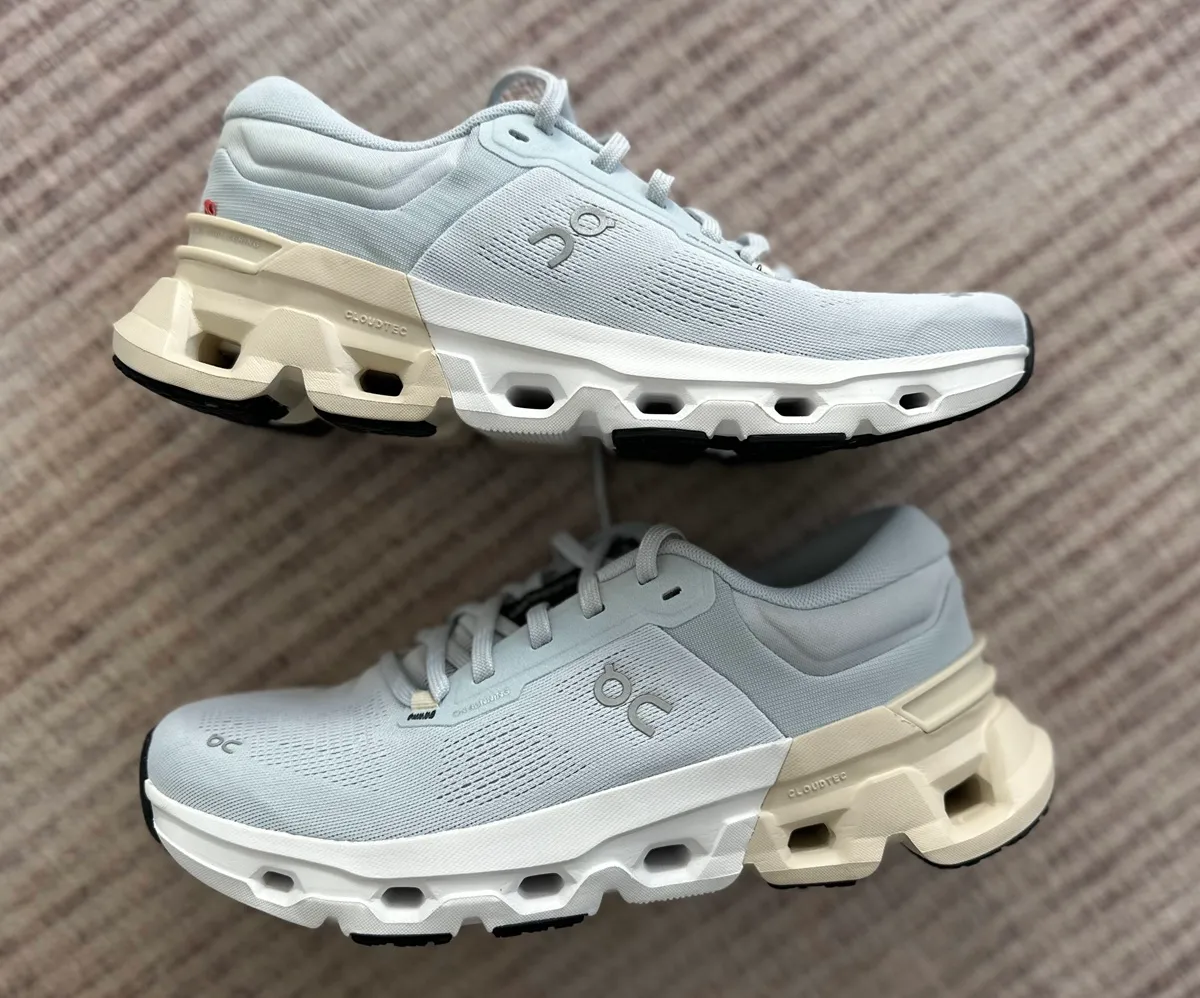
One of the biggest changes is the removal of the speedboard polymer plate in the midsole. On decided to do away with this to help provide that plush feel.
Unfortunately, we just don’t agree with it being plush… maybe slightly softer than the 4. If you liked the Cloudflyer 4, chances are you’ll still be a fan of this one.
Just like the On website describes, the Cloudflyer 5 gives a “foot-hugging feel” straight out of the box.
- Weight: 8.8 oz women’s, 10.6 oz men’s
- Heel drop: 9mm
- Available in 5 colors
- Not available in wide
- Available from On Running for $170
- Read our full review of the On Cloudflyer 5 here >>
👉ASICS GEL Kayano
The GEL Kayano is now in its 32nd iteration and known as one of the best stability shoes on the market. Great for overpronators seeking stability, the GEL Kayano is an ideal shoe for marathons.
It’s more cushioned than most stability shoes and thus has remained a favorite of many runners for a very long time. To be clear, it’s not that plush max cushion feel, but a moderate underfoot feel that allows for pronation correction.
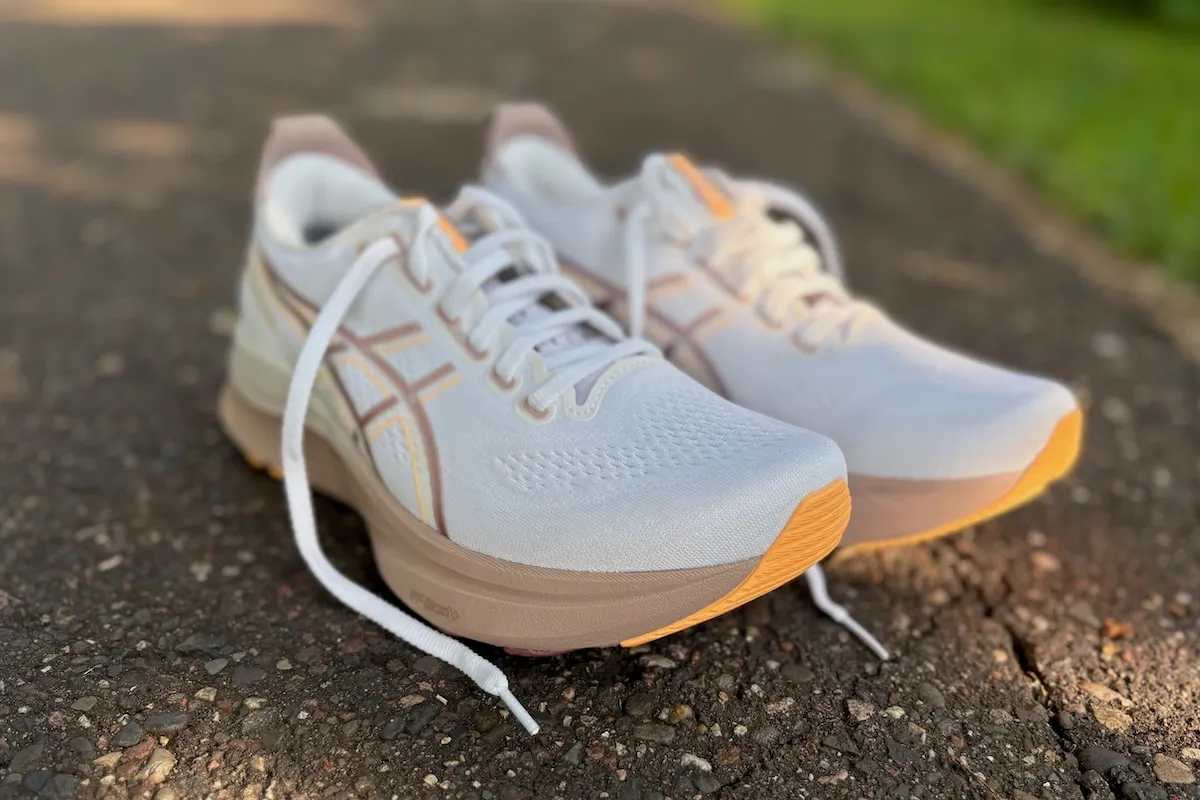
The fit is in line with most shoes, but you will notice a bit more of a heel lock. This is again to help with that foot pronation without over correcting.
- Weight: 10.7 oz Men’s, 9.1 oz Women’s
- Stack Height: 40 mm
- Heel Drop: 8 mm
- Available in nine colors
- Available in wide and narrow
- Available at Asics.com for $165.00
- Read our full review of the Asics Gel-Kayano 32 here >>
Neutral Running Shoe
👉On Cloudsurfer
This latest shoe combines soft, cushioned foam in the midsole, a redesigned upper and a firm rubber outsole. I was pleasantly surprised with how comfortable the footbed felt the first time I tried these on, and that had me constantly coming back for more.
Cloudsurfer 2 is a moderate cushioned, lower stack height, running shoe for shorter easy runs that’s also high on our list of great walking shoes.
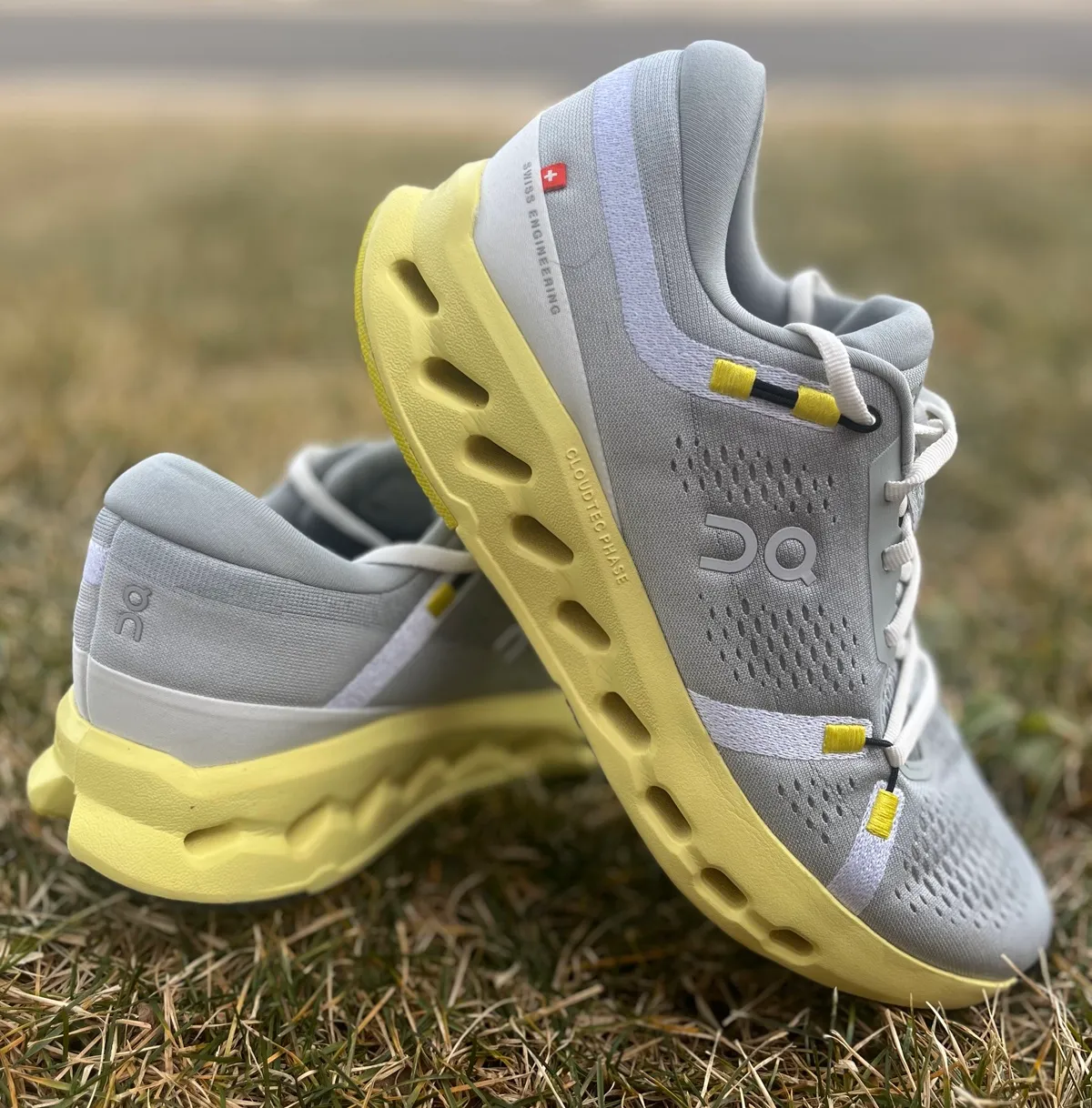
For a daily trainer, these have the right amount of energy return and cushion while feeling breathable and secure on your feet. The cushioned midsole of these shoes isn’t overly plush, which does feel like a departure from prior Cloudsurfer models. The changes to this shoe’s midsole still feel extremely comfortable.
At 9oz, the Cloudsurfer 2 is lightweight but feels supportive enough to protect you through a variety of runs. It balances performance with weight in a way that makes this a reliable, smooth trainer.
- Weight: 7.9 oz women’s, 9.2 oz men’s
- Heel drop: 9mm
- Available in 4 colors
- Not available in wide
- Available at On Running for $160
- Read our full review of the On Cloudsurfer 2 here >>
👉Asics Novablast 5
The Novablast has been a winning max cushion shoe from Asics since it first launched and they have continued to increase the amount of cushion in the shoe, while working to drop the weight. It’s not going to be the plush shoe you’ll see below, but it’s a great amount of cushion in a weight that’s going to translate to a lot of miles for the average runner from training even to race day.
The 5 has a completely new full length midsole with their FF Blast Max foam. Again, I like that this shoe is a more responsive cushion and you don’t sink in to it so much.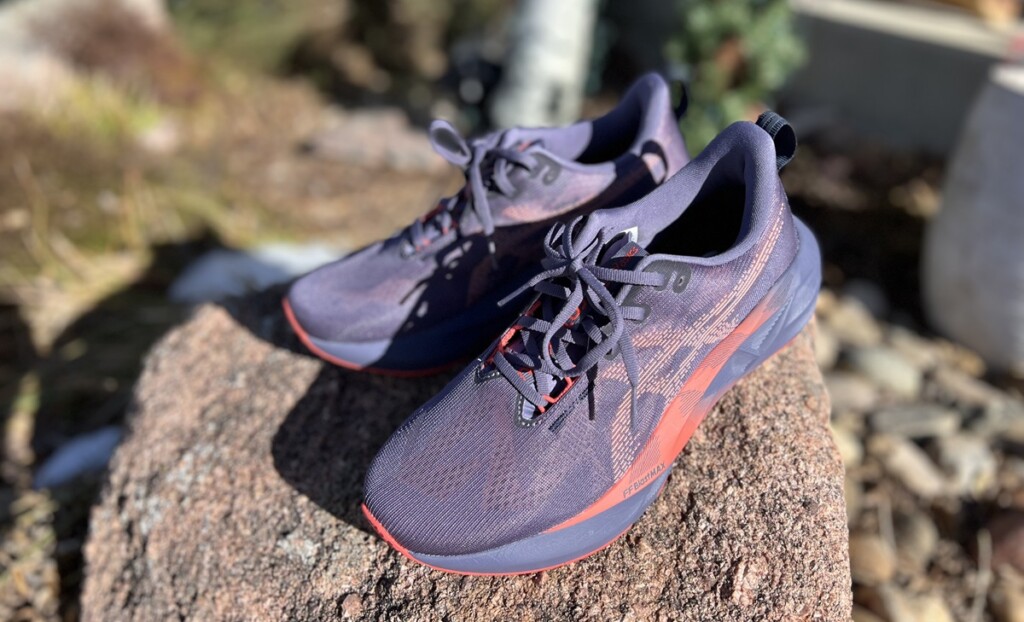
While this is a neutral shoe, with no guiderails or anything for stability, it absolutely has some of that built in to the design. The width of the platform from toe to heel reduces pronation and provides a really good ride.
- Weight: 7.9 oz women’s, 9.1 oz men’s
- Heel drop: 8mm
- 8 colors available
- Not available in wide
- Available at Asics.com for $160 (
- Read my full review of the Asics Novablast 5 here>>
Cushioned Running Shoe
👉ON Cloudmonster
This is not a max cushioned shoe, but a good moderate cushion that works for a lot of different runs. That being said, I know they are moving towards the On Cloudsurfer Max as a 2025 release to be their max shoe.
This was one of the first On shoes that immediately got me hooked. I have now been running in it for over a year and continue to like that this shoe isn’t super squishy soft, but isn’t hard like previous On Running shoes. I always try to compare it to the HOKA Bondi, which feels like you put your foot in a cloud and this is not that kind of soft, it’s also not the Vaporfly bouncy kind of soft. For On the cushion is more about the absorbing of impact, rather than what you might think of as traditional cushion. That’s not a bad thing, just different expectations.
I always try to compare it to the HOKA Bondi, which feels like you put your foot in a cloud and this is not that kind of soft, it’s also not the Vaporfly bouncy kind of soft. For On the cushion is more about the absorbing of impact, rather than what you might think of as traditional cushion. That’s not a bad thing, just different expectations.
This absolutely felt like the most cushioned On running shoe I’ve tested for long runs. It’s not too soft, just a nice cushion. Making it a good daily easy run trainer. Then of course they released the On Cloudeclipse and it’s definitely next level max cushion, but being replaced as noted above.
- Heel Drop: 6mm
- Weight: 8.11oz women’s, 10.76oz men’s
- Available in 2 colors
- Not available in wide
- Available at On Running, REI and retail stores for $170
- See my full review of the On Cloudmonster here >>
👉ASICS GEL Nimbus 27
This shoe will appeal to most runners looking for a neutral fit and some MAX Cushion.
This is the plushest shoe in their line up with a great big old stack height and we’re here for it. The most recent model feels like a great update to a shoe that will carry a lot of runners over long miles with foam that’s durable and a fit that isn’t overly soft.
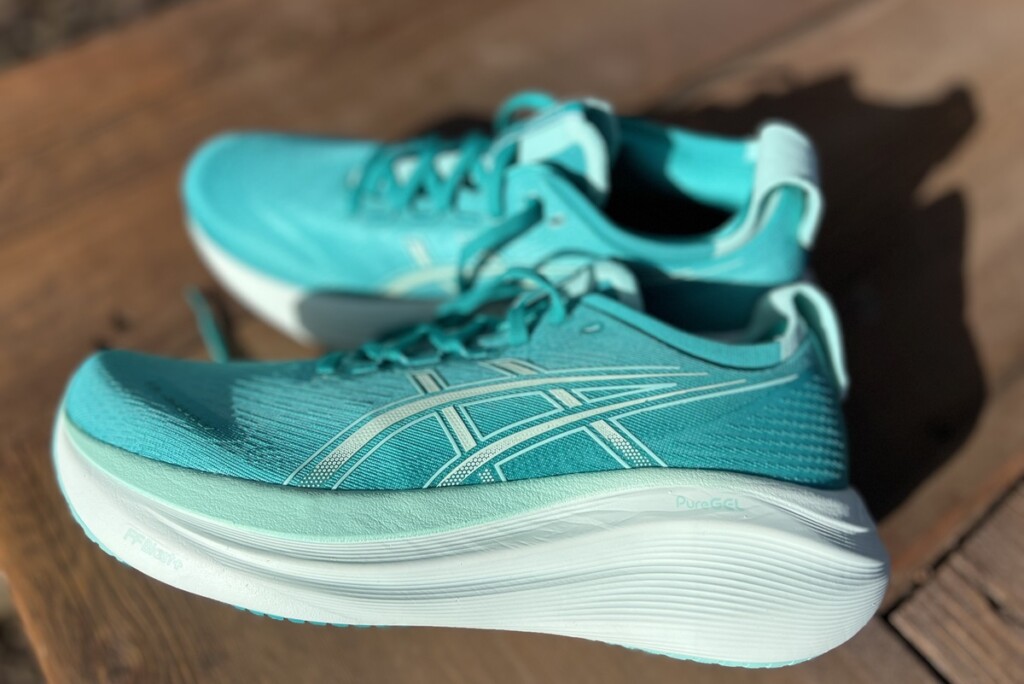 With the 42mm stack height, they did manage to retain a feeling of stability. The firmness that I wasn’t a huge fan of with the last one (because why should a max shoe feel firm) is gone and now it’s just a big cushioned ride.
With the 42mm stack height, they did manage to retain a feeling of stability. The firmness that I wasn’t a huge fan of with the last one (because why should a max shoe feel firm) is gone and now it’s just a big cushioned ride.
For me personally, I can’t say it’s a shoe I’d wear for anything other than easy runs. I certainly wouldn’t turn to it for tempo work or a race where a PR is the goal.
- Weight: 9.2 oz Women’s, 10.7 oz Men’s
- Heel Drop: 8mm
- 4 colors
- Not available in wide
- Available at Asics.com for $160
- See our full Asics Gel Nimbus 27 review >>
Carbon Fiber Plate Shoes
Are they cool new technology, yes.
Do they last as long as your other shoes, nope.
So if you want to test these out use them for speed work and then race day!
👉ASICS Metaspeed Sky and Edge
ASICS is trying to catch up in this area and released a few shoes all at once which many folks can’t quit tell apart. The Edge is going to be the shoe with less cushion, less weight and better for those racing sub 3, etc.
This is a maximum cushioned carbon fiber plate for the marathon runner in you. It’s going to give you both that feeling of comfort over the miles along with the pop that’s often lost in a highly cushioned shoe.
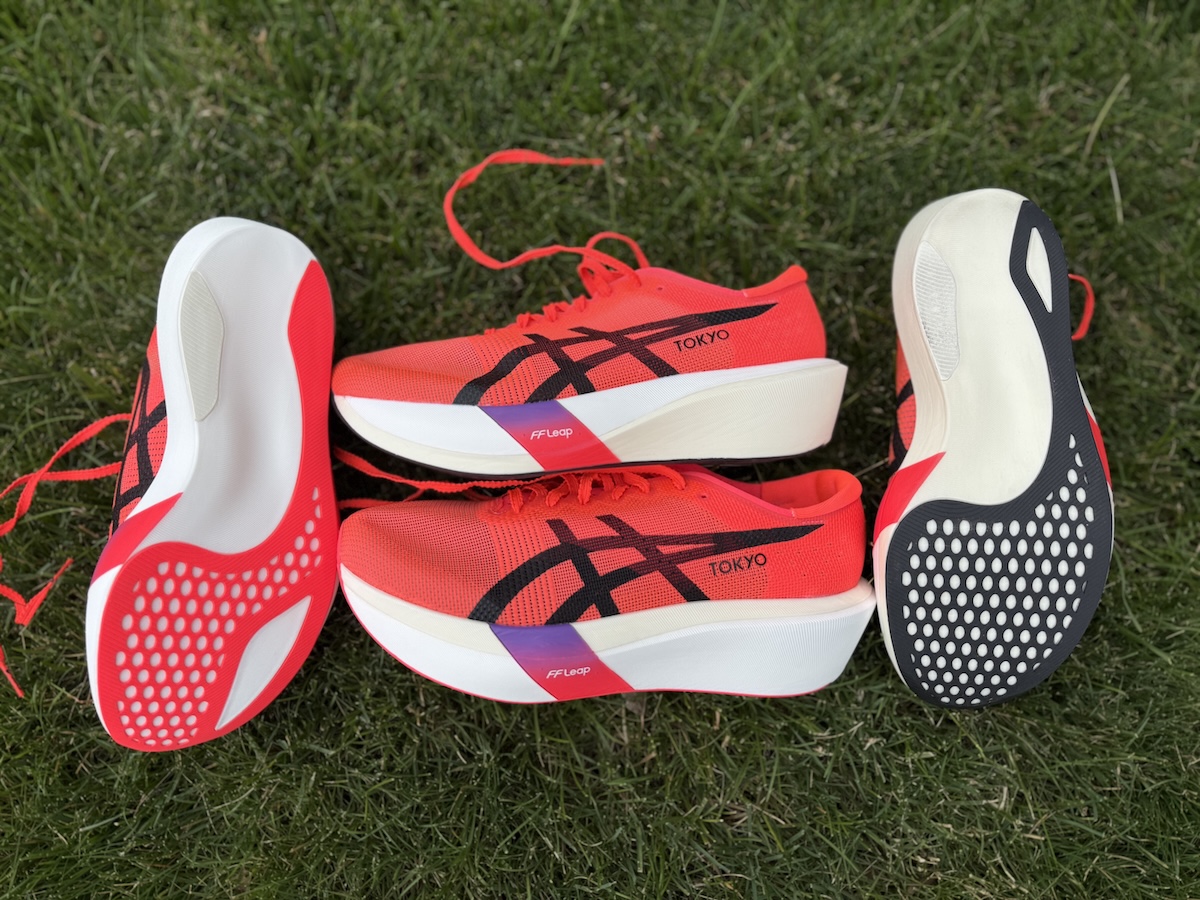
- Weight: 5.8 oz Unisex sizing
- Heel drop: 5 mm
- 4 colors
- Not available in wide
- Available from Asics.com for $250
- Read our detailed Asics Metaspeed Sky vs Edge to know which is right for you
👉On Cloudboom Strike
After seeing Helen Obiri win Boston, a lot of runners stood up to take notice of what On was doing with carbon fiber. It’s a very different type of shoe than Nike and for a lot of runners, that’s a good thing.
Slipping on the On Cloudboom Strike, I could tell right away a lot of things had changed from the first model in 2020. Changed for the better!
- Increased cushion for distance running
- No pods along the bottom to collect rocks
- Better overall fit and foot room
This shoe has a wider fit than say the Vaporfly and even with the high stack, has a pretty stable feel. We really like the overall bounce and energy you get from this model.
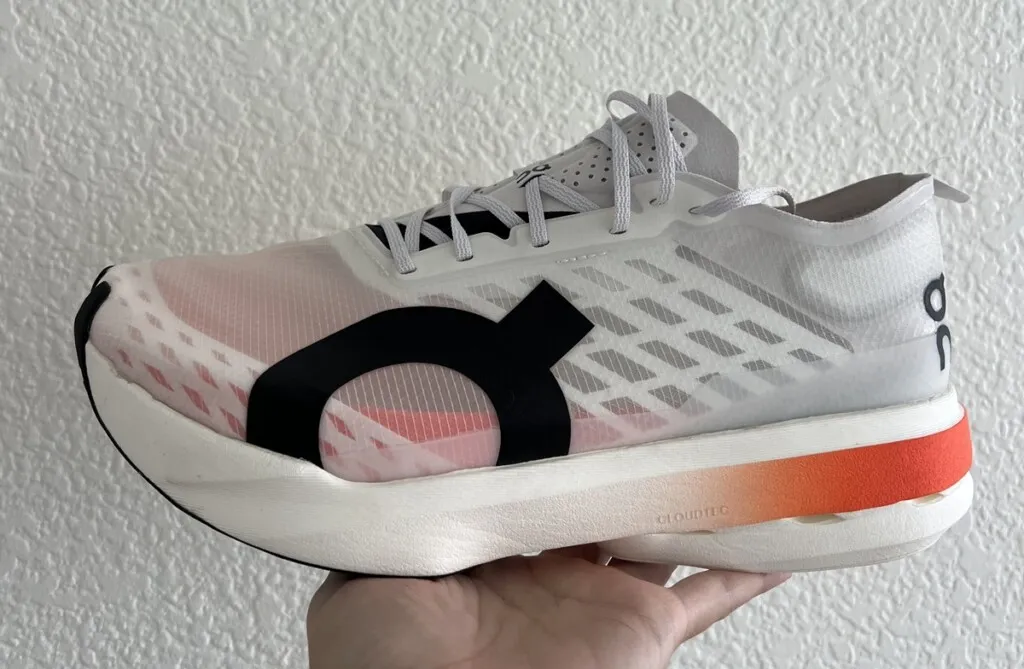
- Weight: 6.8 women’s, 7.7 men’s
- Heel drop: 4mm
- Available in 2 colors
- Not available in wide
- Available at On Running for $280
- Detailed review of the On Cloudboom Strike >>
Trail Running Shoes
Listen do we think that Asics trail shoes are the best of the best…probably not, but they are incredibly affordable if you aren’t doing technical trails and know you like their shoes.
👉On Cloudultra
Welcome to their trail shoe with the highest amount of cushioning. The flip release on the shoe laces, also makes it easy to adjust the tigthness of the shoes. Which as we know is often needed during ultras when feet swell.
The On Cloudultra is one of On Running’s newest trail running shoes and an excellent addition to the ultramarathon and endurance trail running market.
Partially because they shifted the pod set up, so you will catch less rocks than with the road shoes!! They add lugs for more grip and took the pods way, way down.
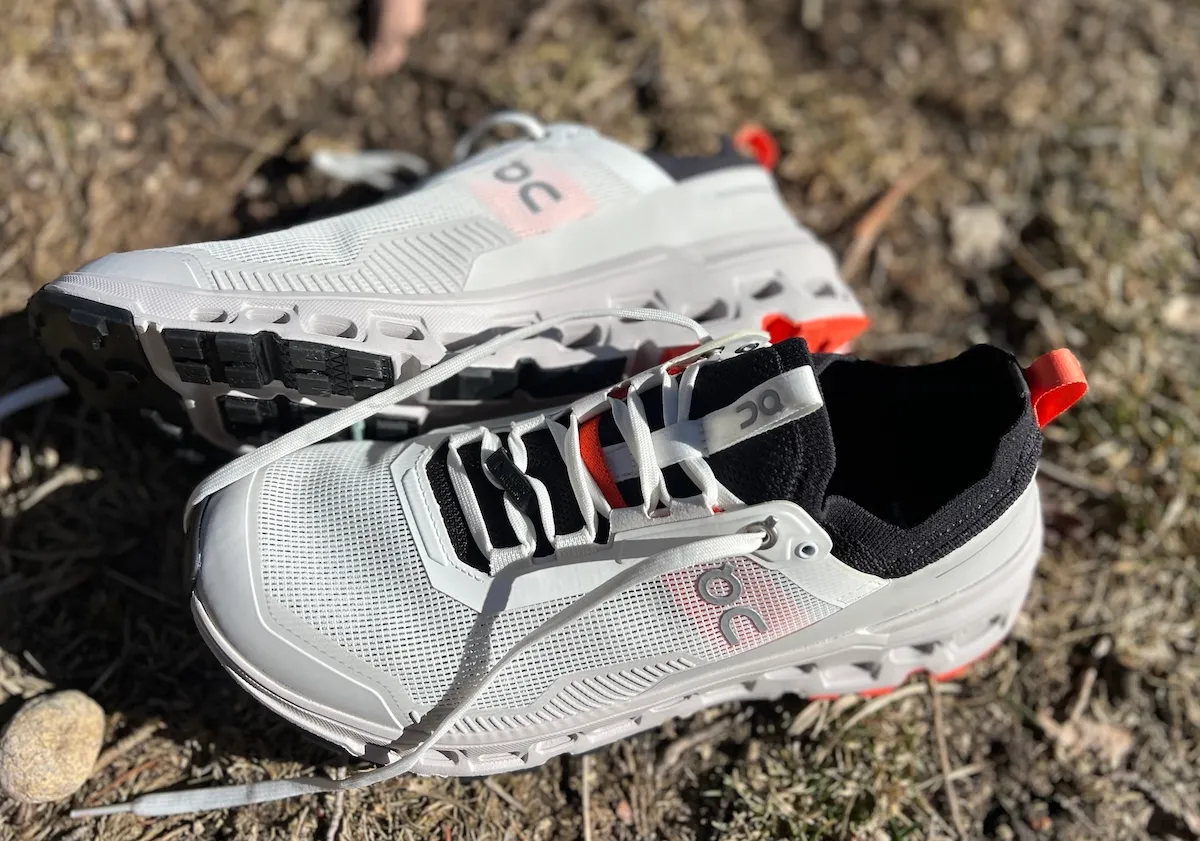
On has satisfied the request of thousands of trail runners with this shoe, thanks to its ability to tackle tricky terrain effectively and remain comfortable over long distances on trails and highways with its Helion midsole foam.
These are excellent trail running footwear for all distances up to and including the marathon.
- Weight: 10.4 oz Men’s, 9.3 oz Women’s
- Heel drop: 5mm
- 4 colors available
- Not available in wide
- Available from On.com for $180
- Check our full review of the On Cloud Ultra 2 here >>
👉ASICS Gel Trabuco 13
We’ll be super honest and say that Asics hasn’t traditionally been a go to for us when it comes to trail running. But that doesn’t mean they aren’t in the space and figuring something out with the cushion that we already love.
If you’re looking to pick up the pace on the trails, this is going to be a great option. Asics used it’s FF BLAST PLUS ECO cushioning in the midsole to help absorb impact underfoot.
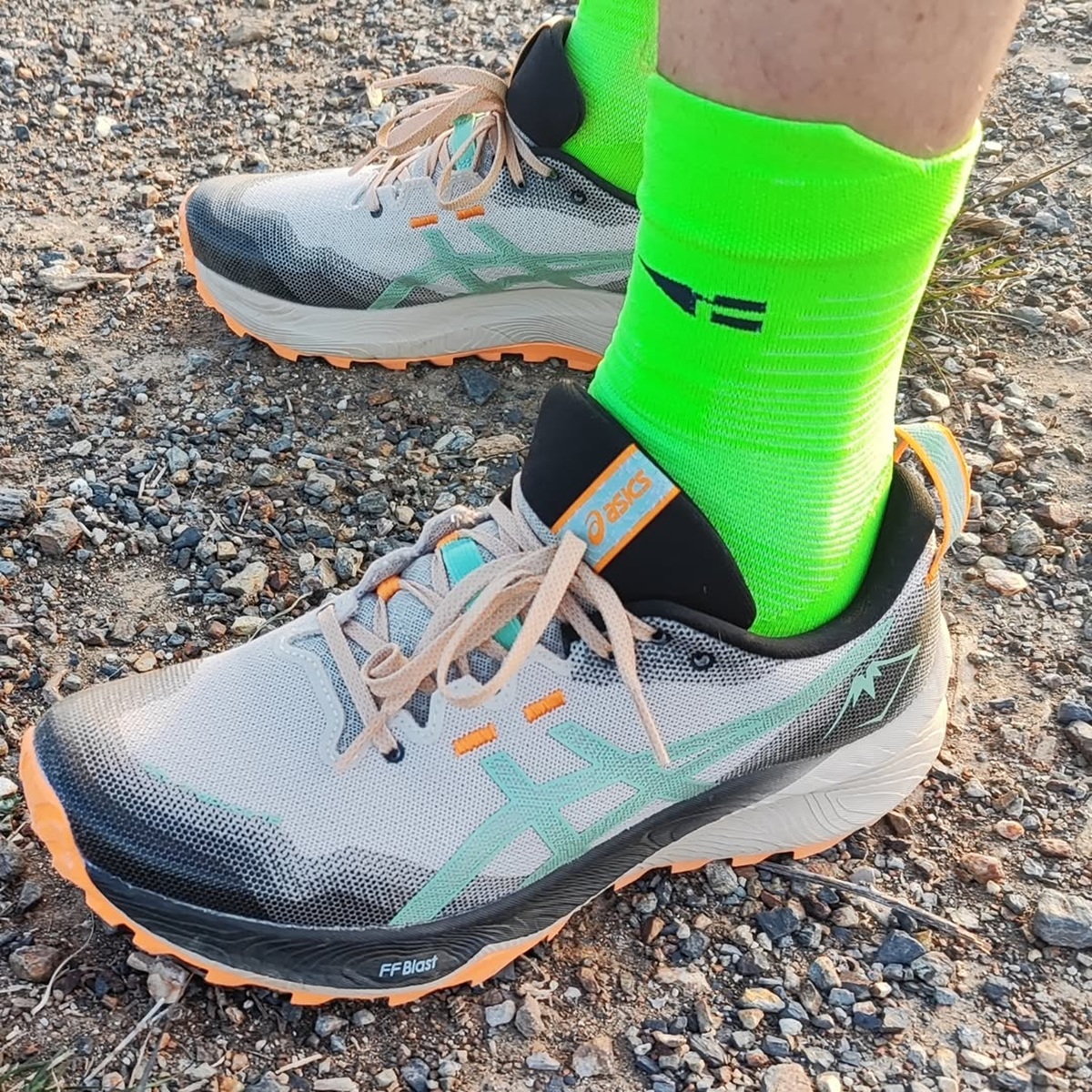
There’s also a rock protection plate at the front of the shoe to help protect your toes if you kick a rock or two while running!
The outsole is designed with the ASICSGRIP rubber to keep you steady on uneven ground and slippery conditions, which is perfect for slippery, more technical trails!
- Weight: 8.8 oz Women’s, 10 oz Men’s
- Heel toe drop: 8 mm
- 4 colors
- Not available in wide
- Available at Asics.com for $140
How to Choose On or ASICS Running Shoes?
Now that we’ve gone through the different models, you have a better feeling for what sets each apart. I can’t recommend enough that you buy knowing you can take them out for a few runs and return.
And remember: Your gait and feet will likely change over time and you may need to change shoes.
This is also why I recommend rotating through several pairs of shoes at once.
Keep in mind that shoe design can change, even with the same model, so always assess how the shoe fits every time you replace a pair.
For more help selecting the right shoe for you, don’t worry, I’ve got you:
- Nike Vs New Balance running shoes
- Altra Running Shoes Review
- Top Marathon Running Shoes
- New Balance Vs Brooks
Other ways to connect with Amanda
Instagram Daily Fun: RunToTheFinish
Facebook Community Chatter: RunToTheFinish
Sign Up to Receive a Weekly Newsletter with Top Running Tips and Laughs



 Skechers Aero Tempo Review | Aptly Named for Speed
Skechers Aero Tempo Review | Aptly Named for Speed